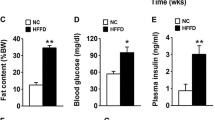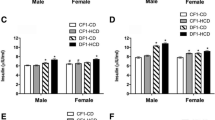Abstract
Purpose
Environmental and nutritional disorders during perinatal period cause metabolic dysfunction in the progeny and impair human health. Advanced glycation end products (AGEs) are primarily produced during metabolism of excess blood glucose, which is observed in diabetes. Methylglyoxal (MG) is a precursor for the generation of endogenous AGEs, which disturbs the metabolism. This work aimed to investigate whether the maternal MG treatment during lactation programs the progeny to metabolic dysfunction later in life.
Methods
Female Wistar rats were divided into two groups: control group (C) treated with saline and MG group treated with MG (60 mg/kg/day) by gavage throughout the lactation period. Both mothers and offspring were fed a standard chow. At weaning, breast milk composition was analyzed and mothers euthanized for blood and tissue sample collections. At 90 days of age, offspring were submitted to glucose tolerance test (ivGTT) and euthanized for blood and tissue samples collection.
Results
MG mothers showed increase in glucose and fructosamine levels; however, they showed low insulin levels and failure in β-cell function (p < 0.05). MG mothers also showed dyslipidemia (p < 0.05). Moreover, breast milk had elevated levels of glucose, triglycerides, cholesterol and fructosamine and low insulin (p < 0.05). Interestingly, MG offspring had increased body weight and adipose tissue at adulthood, and they also showed glucose intolerance and failure in β-cell function (p < 0.05). Besides, MG offspring showed dyslipidemia (p < 0.05) increasing cardiovascular diseases risk.
Conclusions
Maternal MG treatment negatively affects the male rat offspring, leading to type 2 diabetes and dyslipidemia in later life, possibly by changes in breast milk composition.




Similar content being viewed by others
References
Hales CN, Barker DJ (1992) Type 2 (non-insulin-dependent) diabetes mellitus: the thrifty phenotype hypothesis. Diabetologia 35(7):595–601
Barker CJ, Berggren PO (1999) Inositol hexakisphosphate and beta-cell stimulus-secretion coupling. Anticancer Res 19(5A):3737–3741
Lesage J, Sebaai N, Leonhardt M, Dutriez-Casteloot I, Breton C, Deloof S, Vieau D (2006) Perinatal maternal undernutrition programs the offspring hypothalamo-pituitary-adrenal (HPA) axis. Stress 9(4):183–198. doi:10.1080/10253890601056192
Martins PA, Sawaya AL (2006) Evidence for impaired insulin production and higher sensitivity in stunted children living in slums. Br J Nutr 95(5):996–1001
Vieau D, Sebaai N, Leonhardt M, Dutriez-Casteloot I, Molendi-Coste O, Laborie C, Breton C, Deloof S, Lesage J (2007) HPA axis programming by maternal undernutrition in the male rat offspring. Psychoneuroendocrinology 32(Suppl 1):S16–S20
Moura AS, Carpinelli AR, Barbosa FB, Gravena C, Mathias PC (1996) Undernutrition during early lactation as an alternative model to study the onset of diabetes mellitus type II. Res Commun Mol Pathol Pharmacol 92(1):73–84
de Oliveira JC, Scomparin DX, Andreazzi AE, Branco RC, Martins AG, Gravena C, Grassiolli S, Rinaldi W, Barbosa FB, Mathias PC (2011) Metabolic imprinting by maternal protein malnourishment impairs vagal activity in adult rats. J Neuroendocrinol 23(2):148–157. doi:10.1111/j.1365-2826.2010.02095.x
Li M, Sloboda DM, Vickers MH (2011) Maternal obesity and developmental programming of metabolic disorders in offspring: evidence from animal models. Exp Diabetes Res 2011:592408. doi:10.1155/2011/592408
Lisboa PC, de Oliveira E, Manhaes AC, Santos-Silva AP, Pinheiro CR, Younes-Rapozo V, Faustino LC, Ortiga-Carvalho TM, Moura EG (2015) Effects of maternal nicotine exposure on thyroid hormone metabolism and function in adult rat progeny. J Endocrinol 224(3):315–325. doi:10.1530/JOE-14-0473
Habener JF, Kemp DM, Thomas MK (2005) Minireview: transcriptional regulation in pancreatic development. Endocrinology 146(3):1025–1034. doi:10.1210/en.2004-1576
Oben JA, Patel T, Mouralidarane A, Samuelsson AM, Matthews P, Pombo J, Morgan M, McKee C, Soeda J, Novelli M, Poston L, Taylor P (2010) Maternal obesity programmes offspring development of non-alcoholic fatty pancreas disease. Biochem Biophys Res Commun 394(1):24–28. doi:10.1016/j.bbrc.2010.02.057
Melo AM, Benatti RO, Ignacio-Souza LM, Okino C, Torsoni AS, Milanski M, Velloso LA, Torsoni MA (2014) Hypothalamic endoplasmic reticulum stress and insulin resistance in offspring of mice dams fed high-fat diet during pregnancy and lactation. Metabolism 63(5):682–692. doi:10.1016/j.metabol.2014.02.002
Chen H, Simar D, Lambert K, Mercier J, Morris MJ (2008) Maternal and postnatal overnutrition differentially impact appetite regulators and fuel metabolism. Endocrinology 149(11):5348–5356. doi:10.1210/en.2008-0582
Goldberg T, Cai W, Peppa M, Dardaine V, Baliga BS, Uribarri J, Vlassara H (2004) Advanced glycoxidation end products in commonly consumed foods. J Am Diet Assoc 104(8):1287–1291. doi:10.1016/j.jada.2004.05.214
Vlassara H (2005) Advanced glycation in health and disease: role of the modern environment. Ann N Y Acad Sci 1043:452–460. doi:10.1196/annals.1333.051
Clarke RE, Dordevic AL, Tan SM, Ryan L, Coughlan MT (2016) Dietary advanced glycation end products and risk factors for chronic disease: a systematic review of randomised controlled trials. Nutrients. doi:10.3390/nu8030125
Brownlee M (2001) Biochemistry and molecular cell biology of diabetic complications. Nature 414(6865):813–820. doi:10.1038/414813a
de Courten B, de Courten MP, Soldatos G, Dougherty SL, Straznicky N, Schlaich M, Sourris KC, Chand V, Scheijen JL, Kingwell BA, Cooper ME, Schalkwijk CG, Walker KZ, Forbes JM (2016) Diet low in advanced glycation end products increases insulin sensitivity in healthy overweight individuals: a double-blind, randomized, crossover trial. Am J Clin Nutr. doi:10.3945/ajcn.115.125427
Wells-Knecht KJ, Zyzak DV, Litchfield JE, Thorpe SR, Baynes JW (1995) Mechanism of autoxidative glycosylation: identification of glyoxal and arabinose as intermediates in the autoxidative modification of proteins by glucose. Biochemistry 34(11):3702–3709
Thornalley PJ (1990) The glyoxalase system: new developments towards functional characterization of a metabolic pathway fundamental to biological life. Biochem J 269(1):1–11
Degen J, Vogel M, Richter D, Hellwig M, Henle T (2013) Metabolic transit of dietary methylglyoxal. J Agric Food Chem 61(43):10253–10260. doi:10.1021/jf304946p
Berlanga J, Cibrian D, Guillen I, Freyre F, Alba JS, Lopez-Saura P, Merino N, Aldama A, Quintela AM, Triana ME, Montequin JF, Ajamieh H, Urquiza D, Ahmed N, Thornalley PJ (2005) Methylglyoxal administration induces diabetes-like microvascular changes and perturbs the healing process of cutaneous wounds. Clin Sci (Lond) 109(1):83–95. doi:10.1042/CS20050026
Guarda DS, Lisboa PC, de Oliveira E, Nogueira-Neto JF, de Moura EG, Figueiredo MS (2014) Flaxseed oil during lactation changes milk and body composition in male and female suckling pups rats. Food Chem Toxicol 69C:69–75. doi:10.1016/j.fct.2014.04.003
Friedewald WT, Levy RI, Fredrickson DS (1972) Estimation of the concentration of low-density lipoprotein cholesterol in plasma, without use of the preparative ultracentrifuge. Clin Chem 18(6):499–502
Fagundes AT, Moura EG, Passos MC, Santos-Silva AP, de Oliveira E, Trevenzoli IH, Casimiro-Lopes G, Nogueira-Neto JF, Lisboa PC (2009) Temporal evaluation of body composition, glucose homeostasis and lipid profile of male rats programmed by maternal protein restriction during lactation. Horm Metab Res 41(12):866–873. doi:10.1055/s-0029-1233457
Nogales F, Ojeda ML, Del Valle PM, Serrano A, Murillo ML, Carreras Sanchez O (2015) Metabolic syndrome and selenium during gestation and lactation. Eur J Nutr. doi:10.1007/s00394-015-1129-1
Miranda RA, Agostinho AR, Trevenzoli IH, Barella LF, Franco CC, Trombini AB, Malta A, Gravena C, Torrezan R, Mathias PC, de Oliveira JC (2014) Insulin oversecretion in MSG-obese rats is related to alterations in cholinergic muscarinic receptor subtypes in pancreatic Islets. Cell Physiol Biochem 33(4):1075–1086. doi:10.1159/000358677
Franco JG, Fernandes TP, Rocha CP, Calvino C, Pazos-Moura CC, Lisboa PC, Moura EG, Trevenzoli IH (2012) Maternal high-fat diet induces obesity and adrenal and thyroid dysfunction in male rat offspring at weaning. J Physiol 590(21):5503–5518. doi:10.1113/jphysiol.2012.240655
Lima NS, de Moura EG, Passos MC, Nogueira Neto FJ, Reis AM, de Oliveira E, Lisboa PC (2011) Early weaning causes undernutrition for a short period and programmes some metabolic syndrome components and leptin resistance in adult rat offspring. Br J Nutr 105(9):1405–1413. doi:10.1017/S0007114510005064
Meerwaldt R, Links T, Zeebregts C, Tio R, Hillebrands JL, Smit A (2008) The clinical relevance of assessing advanced glycation endproducts accumulation in diabetes. Cardiovasc Diabetol 7:29. doi:10.1186/1475-2840-7-29
DePerno CS, Chitwood MC, Kennedy-Stoskopf S, Jenks JA (2015) Fructosamine: an Alternative to Serum Glucose Measurement in White-tailed Deer (Odocoileus virginianus). J Wildl Dis 51(4):876–879. doi:10.7589/2014-07-182
Vetter SW (2015) Glycated serum albumin and AGE receptors. Adv Clin Chem 72:205–275. doi:10.1016/bs.acc.2015.07.005
Howie GJ, Sloboda DM, Kamal T, Vickers MH (2009) Maternal nutritional history predicts obesity in adult offspring independent of postnatal diet. J Physiol 587(4):905–915. doi:10.1113/jphysiol.2008.163477
Younes-Rapozo V, de Moura EG, Lima ND, Barradas PC, Manhaes AC, de Oliveira E, Lisboa PC (2012) Early weaning is associated with higher neuropeptide Y (NPY) and lower cocaine- and amphetamine-regulated transcript (CART) expressions in the paraventricular nucleus (PVN) in adulthood. Br J Nutr 108(12):2286–2295. doi:10.1017/S0007114512000487
Ikeda N, Shoji H, Murano Y, Mori M, Matsunaga N, Suganuma H, Ikeno M, Hisata K, Hirayama S, Ueno T, Miida T, Shimizu T (2014) Effects of breastfeeding on the risk factors for metabolic syndrome in preterm infants. J Dev Orig Health Dis 5(6):459–464. doi:10.1017/S2040174414000397
Franco JG, Dias-Rocha CP, Fernandes TP, Albuquerque Maia L, Lisboa PC, Moura EG, Pazos-Moura CC, Trevenzoli IH (2015) Resveratrol treatment rescues hyperleptinemia and improves hypothalamic leptin signaling programmed by maternal high-fat diet in rats. Eur J Nutr. doi:10.1007/s00394-015-0880-7
Conceição EP, Trevenzoli IH, Oliveira E, Franco JG, Carlos AS, Nascimento-Saba CC, Moura EG, Lisboa PC (2011) Higher white adipocyte area and lower leptin production in adult rats overfed during lactation. Horm Metab Res 43(7):513–516. doi:10.1055/s-0031-1275702
Coughlan MT, Yap FY, Tong DC, Andrikopoulos S, Gasser A, Thallas-Bonke V, Webster DE, Miyazaki J, Kay TW, Slattery RM, Kaye DM, Drew BG, Kingwell BA, Fourlanos S, Groop PH, Harrison LC, Knip M, Forbes JM (2011) Advanced glycation end products are direct modulators of beta-cell function. Diabetes 60(10):2523–2532. doi:10.2337/db10-1033
Zhao Z, Zhao C, Zhang XH, Zheng F, Cai W, Vlassara H, Ma ZA (2009) Advanced glycation end products inhibit glucose-stimulated insulin secretion through nitric oxide-dependent inhibition of cytochrome c oxidase and adenosine triphosphate synthesis. Endocrinology 150(6):2569–2576. doi:10.1210/en.2008-1342
Zhu Y, Shu T, Lin Y, Wang H, Yang J, Shi Y, Han X (2011) Inhibition of the receptor for advanced glycation endproducts (RAGE) protects pancreatic beta-cells. Biochem Biophys Res Commun 404(1):159–165. doi:10.1016/j.bbrc.2010.11.085
Acknowledgments
This work was funded by the Brazilian Foundation: Conselho Nacional de Desenvolvimento Científico e Tecnológico (CNPq), Coordenação de Aperfeiçoamento Pessoal de Nível Superior (CAPES), Paraná Science Foundation (Fundação Araucária).
Author information
Authors and Affiliations
Corresponding author
Ethics declarations
Conflict of interest
The authors have no competing interests.
Additional information
Paulo Cezar de Freitas Mathias and Rodrigo Mello Gomes have contributed equally to this work.
Rights and permissions
About this article
Cite this article
Francisco, F.A., Barella, L.F., Silveira, S.d. et al. Methylglyoxal treatment in lactating mothers leads to type 2 diabetes phenotype in male rat offspring at adulthood. Eur J Nutr 57, 477–486 (2018). https://doi.org/10.1007/s00394-016-1330-x
Received:
Accepted:
Published:
Issue Date:
DOI: https://doi.org/10.1007/s00394-016-1330-x




